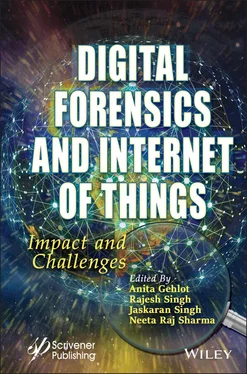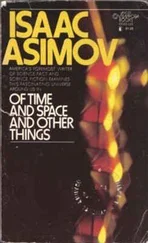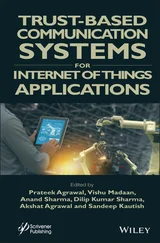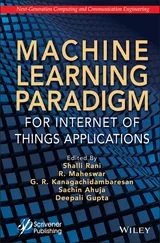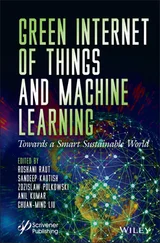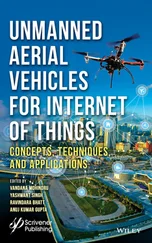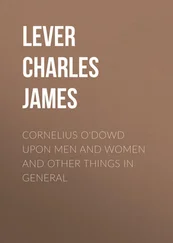Digital Forensics and Internet of Things
Здесь есть возможность читать онлайн «Digital Forensics and Internet of Things» — ознакомительный отрывок электронной книги совершенно бесплатно, а после прочтения отрывка купить полную версию. В некоторых случаях можно слушать аудио, скачать через торрент в формате fb2 и присутствует краткое содержание. Жанр: unrecognised, на английском языке. Описание произведения, (предисловие) а так же отзывы посетителей доступны на портале библиотеки ЛибКат.
- Название:Digital Forensics and Internet of Things
- Автор:
- Жанр:
- Год:неизвестен
- ISBN:нет данных
- Рейтинг книги:3 / 5. Голосов: 1
-
Избранное:Добавить в избранное
- Отзывы:
-
Ваша оценка:
- 60
- 1
- 2
- 3
- 4
- 5
Digital Forensics and Internet of Things: краткое содержание, описание и аннотация
Предлагаем к чтению аннотацию, описание, краткое содержание или предисловие (зависит от того, что написал сам автор книги «Digital Forensics and Internet of Things»). Если вы не нашли необходимую информацию о книге — напишите в комментариях, мы постараемся отыскать её.
It pays to be ahead of the criminal, and this book helps organizations and people to create a path to achieve this goal.
Digital Forensics and Internet of Things Audience
Digital Forensics and Internet of Things — читать онлайн ознакомительный отрывок
Ниже представлен текст книги, разбитый по страницам. Система сохранения места последней прочитанной страницы, позволяет с удобством читать онлайн бесплатно книгу «Digital Forensics and Internet of Things», без необходимости каждый раз заново искать на чём Вы остановились. Поставьте закладку, и сможете в любой момент перейти на страницу, на которой закончили чтение.
Интервал:
Закладка:
Table of Contents
1 Cover
2 Title Page
3 Copyright
4 Preface
5 1 Face Recognition–Based Surveillance System: A New Paradigm for Criminal Profiling 1.1 Introduction 1.2 Image Processing 1.3 Deep Learning 1.4 Methodology 1.5 Conclusion References
6 2 Smart Healthcare Monitoring System: An IoT-Based Approach 2.1 Introduction 2.2 Healthcare at Clinics 2.3 Remote Healthcare 2.4 Technological Framework 2.5 Standard UIs, Shows, and User Requirements 2.6 Cloud-Based Health Monitoring Using IoT 2.7 Information Acquisition 2.8 The Processing of Cloud 2.9 IoT-Based Health Monitoring Using Raspberry Pi 2.10 IoT-Based Health Monitoring Using RFID 2.11 Arduino and IoT-Based Health Monitoring System 2.12 IoT-Based Health Monitoring System Using ECG Signal 2.13 IoT-Based Health Monitoring System Using Android App 2.14 Conclusion and Future Perspectives References
7 3 Design of Gesture-Based Hand Gloves Using Arduino UNO: A Grace to Abled Mankind 3.1 Introduction 3.2 Result and Discussion 3.3 Conclusion 3.4 Future Scope References
8 4 Playing With Genes: A Pragmatic Approach in Genetic Engineering 4.1 Introduction 4.2 Literature Review 4.3 Methodology 4.4 Food and Agriculture 4.5 Impact on Farmers 4.6 Diseases: Gene Editing and Curing 4.7 Conclusion 4.8 Future Scope References
9 5 Digital Investigative Model in IoT: Forensic View 5.1 Introduction 5.2 Application of AI for Different Purposes in Forensic Science 5.3 Future of AI 5.4 Challenges While Implementing AI 5.5 Conclusion References
10 6 Internet of Things Mobility Forensics 6.1 Introduction 6.2 Smart Device and IoT 6.3 Relation of Internet of Things with Mobility Forensics 6.4 Mobility Forensics IoT Investigation Model 6.5 Internet of Things Mobility Forensics: A Source of Information 6.6 Drawbacks in IoT Devices Data Extraction 6.7 Future Perspective of Internet of Things Mobility Forensics 6.8 Conclusion References
11 7 A Generic Digital Scientific Examination System for Internet of Things 7.1 Introduction 7.2 Internet of Things 7.3 IoT Architecture 7.4 Characteristics of IoT 7.5 IoT Security Challenges and Factors of Threat 7.6 Role of Digital Forensics in Cybercrime Investigation for IoT 7.7 IoT Security Steps 7.8 Conclusion References
12 8 IoT Sensors: Security in Network Forensics 8.1 Introduction 8.2 Cybersecurity Versus IoT Security and Cyber-Physical Systems 8.3 The IoT of the Future and the Need to Secure 8.4 Security Engineering for IoT Development 8.5 Building Security Into Design and Development 8.6 Security in Agile Developments 8.7 Focusing on the IoT Device in Operation 8.8 Cryptographic Fundamentals for IoT Security Engineering 8.9 Cloud Security for the IoT 8.10 Conclusion References
13 9 Xilinx FPGA and Xilinx IP Cores: A Boon to Curb Digital Crime 9.1 Introduction 9.2 Literature Review 9.3 Proposed Work 9.4 Xilinx IP Core Square Root 9.5 RTL View of the 8-Bit Multiplier 9.6 RTL View of 8-Bit Down Counter 9.7 Up/Down Counter Simulation Results 9.8 Square Root Simulation Results 9.9 Hardware Device Utilization Reports of Binary Down Counter 9.10 Comparison of Proposed and Existing Work for Binary Up/Down Counter 9.11 Conclusion References
14 10 Human-Robot Interaction: An Artificial Cognition-Based Study for Criminal Investigations 10.1 Introduction 10.2 Methodology 10.3 Architecture Models for Robots 10.4 Cognitive Architecture 10.5 Challenges in the Existing Social Robots and the Future Scopes 10.6 Conclusion 10.7 Robots in Future Pandemics References
15 11 VANET: An IoT Forensic-Based Model for Maintaining Chain of Custody 11.1 Introduction 11.2 Cluster Performance Parameters 11.3 Routing Protocols in VANET 11.4 Internet of Vehicles 11.5 IoT Forensic in Vehicular Ad Hoc Networks 11.6 Conclusion References
16 12 Cognitive Radio Networks: A Merit for Teleforensics 12.1 Introduction 12.2 Contribution of Work 12.3 Conclusion and Future Scope Acknowledgement References
17 13 Fingerprint Image Identification System: An Asset for Security of Bank Lockers 13.1 Introduction 13.2 Result and Discussion 13.3 Conclusion 13.4 Future Scope References
18 14 IoT Forensics: Interconnection and Sensing Frameworks 14.1 Introduction 14.2 The Need for IoT Forensics 14.3 Various Types of Evidences Encountered 14.4 Protocols and Frameworks in IoT Forensics 14.5 IoT Forensics Process Model 14.6 Suggestive Solutions 14.7 Conclusion References
19 15 IoT Forensics: A Pernicious Repercussions 15.1 Introduction: Challenges in IoT Forensics 15.2 Scope of the Compromise and Crime Scene Reconstruction 15.3 Device and Data Proliferation 15.4 Multiple Data Location and Jurisdiction Challenges 15.5 Device Type 15.6 Lack of Training and Weak Knowledge Management 15.7 Data Encryption 15.8 Heterogeneous Software and/or Hardware Specifications 15.9 Privacy and Ethical Considerations by Accessing Personal Data 15.10 Lack of a Common Forensic Model in IoT Devices 15.11 Securing the Chain of Custody 15.12 Lifespan Limitation 15.13 The Cloud Forensic Problem 15.14 The Minimum or Maximum Period in Which Data is Stored in the Cloud 15.15 Evidence Analysis and Correlation 15.16 Conclusion References
20 About the Editors
21 Index
22 End User License Agreement
List of Tables
1 Chapter 3 Table 3.1 Algorithm setting for wheelchair direction.
2 Chapter 7Table 7.1 Strategy for investigating for IoT devices which help in proper chain ...Table 7.2 IoT’s chain of custody and challenges faced by investigators.
3 Chapter 9Table 9.1 Pin details of the 8-bit square root.Table 9.2 Pin details of 8-bit multiplier.Table 9.3 Synthesis report of 8-bit multiplier.Table 9.4 Pin details of 8-bit up counter.Table 9.5 Synthesis report of 8-bit down counter.Table 9.6 Eight-bit down counter IP core synthesis report for Spartan-6 FPGA har...Table 9.7 Synthesis report of an 8-bit square root.Table 9.8 Synthesis report of 8-bit square root IP core.Table 9.9 Comparative table of conventional approach and IP core approach.Table 9.10 Spartan-3E FPGA hardware device utilization summary of different leng...Table 9.11 Spartan-6 FPGA hardware device utilization summary of different lengt...Table 9.12 Area and delay comparison with different FPGAs.Table 9.13 Area and delay comparison with different FPGAs.Table 9.14 Comparison with existing work.Table 9.15 Power calculation.
4 Chapter 10Table 10.1 Compares the various architectures on the basis of the taxonomies, me...
5 Chapter 11Table 11.1 Node description.Table 11.2 General comparison of AODV and DSDV
6 Chapter 13Table 13.1 The physical state, liveness detection, and resolution of current fin...
List of Illustrations
1 Chapter 1 Figure 1.1 Fundamental steps of image processing in face recognition. Figure 1.2 Layers of the model. Figure 1.3 Structure of face recognition system. Figure 1.4 Block diagram of face recognition system. Figure 1.5 Components of the system. Figure 1.6 Welcome to the Raspberry Pi desktop. Figure 1.7 Setup. Figure 1.8 Options on display. Figure 1.9 Image of registration. Figure 1.10 LCD displaying door lock system. Figure 1.11 Unknown face recognized.
2 Chapter 2 Figure 2.1 WSNs connection to the internet. Figure 2.2 IoT-cloud-based remote health monitoring. Figure 2.3 Health monitoring using IoT-based Raspberry Pi. Figure 2.4 Healthcare monitoring model using RFID. Figure 2.5 Arduino-based health monitoring system. Figure 2.6 Healthcare system via IOT. Figure 2.7 Systemic model of health monitoring using ECG signal.
3 Chapter 3 Figure 3.1. Block diagram of gesture-based hand gloves using Arduino UNO. Figure 3.2. Circuit diagram of gesture-based hand gloves using Arduino UNO.
4 Chapter 4 Figure 4.1 Chimeras designed through gene targeting (source: https://en.wikipedi... Figure 4.2 Plasmid method in a bacterial cell.Figure 4.3 Cloning DNA of interest using the vector method.Figure 4.4 Biolistic gene gun.Figure 4.5 BtCotton.Figure 4.6 Flavr-Savr.Figure 4.7 Global adoption rates for biotech crops (million hectares).Figure 4.8 Global adoption rates for biotech crops (million hectares).Figure 4.9 Recent trends in gene therapy research and clinical trials. (a) Diffe...Figure 4.10 CRISPR technology mechanism.
Читать дальшеИнтервал:
Закладка:
Похожие книги на «Digital Forensics and Internet of Things»
Представляем Вашему вниманию похожие книги на «Digital Forensics and Internet of Things» списком для выбора. Мы отобрали схожую по названию и смыслу литературу в надежде предоставить читателям больше вариантов отыскать новые, интересные, ещё непрочитанные произведения.
Обсуждение, отзывы о книге «Digital Forensics and Internet of Things» и просто собственные мнения читателей. Оставьте ваши комментарии, напишите, что Вы думаете о произведении, его смысле или главных героях. Укажите что конкретно понравилось, а что нет, и почему Вы так считаете.
